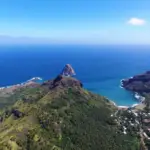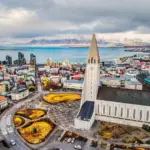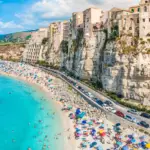
Welcome to the fascinating world of Bolivian Altiplano! A region full of contrasts, where altitudes imposing buildings blend with a rich and vibrant culture. If you're looking for a tourist destination authentic, the Bolivia is the right place and the Bolivian Altiplano is one of the most impressive regions in the country.
Here, majestic mountains, serene lakes, and an ancient culture combine to create a unique experience. From the famous Salar from Uyuni to the vibrant city of There Peace, there is something for everyone in this plateau breathtaking.
If you want to experience the natural wonders or dive into Bolivian culture, the Bolivian Altiplano and the tourist destination right for you. So, let's start exploring all the amazing things this place has to offer!
Main Conclusions:
- The Bolivian Altiplano is a region of contrasts, where altitudes and culture harmonize.
- THE region offers a variety of tourist destinations impressive, like the Uyuni Salt Flats and La Paz.
- THE culture Bolivian is rich and vibrant, permeating all aspects of life in the Bolivian Altiplano.
- THE gastronomy place is delicious, with typical dishes that you won't find anywhere else.
- If you like adventures, the Bolivian Altiplano offers a wide variety of activities adventure tourism, as trekking and mountaineering.
What is the Bolivian Altiplano?
The Bolivian Altiplano is a region located in the south-central part of Bolivia, which covers the departments of La Paz, Oruro and Potosí. This region is famous for its altitudes imposing, landscapes breathtaking and rich and diverse culture.
The Bolivian Altiplano is a plateau located at a altitude average of 3,750 meters above sea level, with peaks exceeding 6,000 meters. This altitude high has a great impact on the region, both in its geography as in their cultural life.
Geography of the Bolivian Altiplano
The Bolivian Altiplano region is made up of a series of mountain ranges, plains, and mountains. The Andes Mountains run through the region, creating landscapes breathtaking. This is where the highest point of the Bolivia, Mount Sajama, with an incredible 6,542 meters.
In addition to the Andes Mountains, the Bolivian Altiplano is marked by the presence of Lake Titicaca, one of the largest lakes of South America and the highest navigable lake in the world.
Plateau and Altitude
THE altitude has a significant impact on the life and culture of the Bolivian Altiplano. Due to this high altitude, the region is known for its cold temperatures, low atmospheric pressure, and intense sunlight, which are unique and distinct from other regions of Bolivia.
These unique climatic conditions have created a unique landscape, with flora and fauna adapted to high altitudes. Furthermore, many of the customs and traditions of the region were formed based on climatic and geographical conditions.
THE geography of the Bolivian Altiplano and its high altitude make this region a tourist destination unique, with landscapes breathtaking, rich culture and unique and passionate experiences.
Main Destinations in the Bolivian Altiplano
If you are planning a trip to the Bolivian Altiplano, you cannot miss these tourist destinations incredible things the region has to offer. Prepare to be enchanted by the natural beauty, rich culture and fascinating history.

Uyuni Salt Flats
THE Uyuni Salt Flats Salar de Uyuni is one of Bolivia's most famous destinations. Spanning 10,582 km², it's the world's largest salt flat and a stunning visual spectacle. The flat, white landscape is the perfect backdrop for surreal photos. Furthermore, Salar de Uyuni is surrounded by volcanoes, colorful lagoons, and unique rock formations, making the visit even more special.

La Paz
La Paz is the administrative capital of Bolivia and a vibrant tourist destination. At 3,640 meters above sea level, it is the highest city in the world and offers incredible views of the snow-capped Andes. Some of La Paz's most famous landmarks include the Valle de la Luna (Moon Valley), the cable car, Plaza Murillo, and the Mercado de las Brujas (Witches' Market).

Tiwanaku
For history lovers, the archaeological site of Tiwanaku is a must-see. Located about 70 km from La Paz, it is one of the most important areas in South America in terms of cultural heritage. Tiwanaku was a religious, political and cultural center of civilization Tiwanaku, which existed between 400 and 900 AD. The most important tourist attractions include the Sun Gate, the Kalasasaya Temple and the Tiwanaku Museum.

Lake Titicaca
Located on the border between Bolivia and Peru, the lake Titicaca is the highest navigable lake in the world, at an altitude of 3,812 meters. It is a sacred place for indigenous peoples and offers stunning landscapes and picturesque islands. Some of the most famous tourist attractions include Sun Island, Moon Island, Pilcocaina Temple, and Chalalan Market.
Culture and Traditions of the Bolivian Altiplano
If you're looking for a unique and authentic experience, the Bolivian Altiplano is the ideal destination. The region is rich in Bolivian culture and traditions, which enchant visitors and rescue the history and identity of the local people.
One of the main characteristics of Bolivian culture is the presence of native indigenous culture. customs, in the dances and in the festivals, it is possible to perceive this influence and the importance it has for the Bolivian people.
You customs and traditions of indigenous peoples are preserved to this day and can be seen in various cultural manifestations, such as in music and dance typical of the region. These activities are a way to keep the tradition alive and pass it on to future generations.
You festivals are also an important part of Bolivian culture and tradition. Every year, thousands of tourists visit the country to participate and experience these festivities firsthand. One example is the Oruro Carnival, considered an Intangible Cultural Heritage of Humanity by UNESCO, which brings together traditional dances, music, and costumes.
Another example is the All Saints' Day celebration, when Bolivian families gather to honor their loved ones who have passed away. The celebrations involve plenty of food, drink, and music, as well as decorations with flowers and candles in churches and cemeteries.

Typical Bolivian costume
Traditional Bolivian attire is a cultural expression that also deserves to be highlighted. Costumes vary by region of the country, but they all share common elements, such as vibrant colors and handcrafted fabrics.
In the Bolivian Altiplano, the typical costume consists of long skirts, embroidered blouses and colorful blankets, which protect from the cold and are part of women's daily attire.
Men wear hats, ponchos, and wide-legged pants, which also have indigenous influences in their designs and textures. Traditional attire is a way of demonstrating cultural identity and is highly valued by Bolivians.
The Gastronomy of the Bolivian Altiplano
The Bolivian Altiplano is a true paradise for nature lovers. gastronomy. The local cuisine is a blend of indigenous, Spanish and Andean traditions, resulting in authentic flavors and delicious dishes.
Try the typical dishes Try the region's favorite dishes, such as the famous "salteñas," a type of pastry filled with meat, potatoes, eggs, onions, and olives. Or try "api con pastel," a hot drink made with purple corn, cinnamon, and cloves, served with fried pastries.
Freshwater fish are a local specialty, especially in the majestic Lake Titicaca. Try the “stuffed fish” or the “fish in peanut sauce” for a true gastronomic experience.
The Bolivian Altiplano is also a perfect place to sample the delicious varieties of potatoes, corn, and quinoa grown in the region. Don't forget to try chuño, a type of dried and frozen potato that can be boiled or fried.
| Typical Dishes | Drinks |
|---|---|
| Salteñas | Chicha |
| Api con pastel | Mocochinchi |
| Stuffed fish | Empanadas |
| Fish in peanut sauce | Paceña Beer |
As you can see, the gastronomy The Bolivian Altiplano is rich and diverse, with many delicious options to try during your stay. Don't miss the opportunity to explore the authentic flavors of Bolivian cuisine.

Adventures in the Bolivian Altiplano
If you're looking for an adrenaline rush, the Bolivian Altiplano is the perfect destination for you! With its impressive altitudes and surreal natural landscapes, adventure tourism is one of the main attractions in the region.
One of the most famous activities is the trekking, with several trail options of varying difficulty levels. If you are an experienced mountaineer, you can take on the challenge of climbing Huayna Potosí, one of the most iconic mountains in the countryThe views at the top are simply spectacular and worth every drop of sweat.
But if you prefer lighter activities, don't worry! The region also offers other incredible options, such as the Ruta de la Muerte bike tour, a winding and challenging road that winds through the mountains.
Another option is to observe flora and fauna, a unique experience in nature. In the Bolivian Altiplano, you can find many species of animals and plants typical of the region, such as vicuñas, llamas, and giant cacti.
Trekking in the Bolivian Altiplano
If you are a lover of trekking, you can't miss the trails of the Bolivian Altiplano. But before you venture out, remember to hire a local guide to ensure your security and know the best routes.
| Trail | Difficulty level | Duration |
|---|---|---|
| Coroico Path | Average | 3 days |
| Illampu | Difficult | 5 days |
| Condoriri | Average | 2 days |
Regardless of the trail you choose, it's important to be prepared with appropriate equipment and be well-informed about the region's weather conditions.
Mountaineering in the Bolivian Altiplano
For lovers of mountaineering, the Bolivian Altiplano offers a variety of summit options. Among the most famous mountains are Huayna Potosí and Illimani, both over 6,000 meters high.
Although the mountaineering While it's a challenging activity, the views from the top are breathtaking and certainly worth the effort. Again, it's important to hire an experienced guide and be prepared with appropriate equipment.
Adventure tourism in the Bolivian Altiplano
In addition to trekking and mountaineering, the Bolivian Altiplano also offers other incredible options. adventure tourism, such as rafting, canoeing, mountain biking, and more. It's worth noting that activities depend on weather conditions and seasons, so it's a good idea to get informed in advance.
Regardless of the type of activity chosen, the Bolivian Altiplano is the perfect destination for those seeking excitement and contact with nature. With its unique beauty and adventure options, the region has everything it needs to be a unforgettable experience.
Travel Tips for the Bolivian Altiplano
Planning a trip to the Bolivian Altiplano can seem a bit daunting, but with a few helpful tips, you can ensure your travel experience is the best it can be. Here are a few... essential tips to help you prepare for your adventure in the Bolivian highlands:
Planning
Before traveling to the Bolivian Altiplano, it is important to research the destination and prepare a good planning. Make sure the attractions you want to visit are open during your stay, make reservations accommodation in advance and set a flexible itinerary, allowing you to adjust your schedule as needed.
Required Documents
To enter Bolivia, you'll need a valid passport and a visa, which can be obtained at the nearest Bolivian embassy. It's also important to carry a copy of your travel documents as a backup in case they're lost or stolen.
Climate
The Bolivian Altiplano has a climate Varied, with extreme temperatures, especially at night. It's important to be prepared for temperature changes by bringing appropriate clothing for different weather conditions, such as strong winds, rain, and low temperatures.
Security
The Bolivian Altiplano is a safe region, but it's always a good idea to be vigilant during your trip. Avoid displaying valuables, walking in isolated areas at night, and be wary of scams common among tourists. Also, stay informed about the current situation in the region, check the latest news, and follow the guidance of local authorities.
Other Tips
- Bring cash, as many places do not accept credit cards;
- Bring sunscreen and lip balm to protect your skin from the strong sun and climate dry region;
- Always carry mineral water to avoid dehydration;
- Learn some basic words in Spanish to make it easier to communicate with others. residents local;
- Make sure you have valid travel insurance, including coverage for medical emergencies.
By following these tips, you'll be prepared to make the most of your trip to the Bolivian Altiplano. Enjoy the beauties natural, the rich culture and the adventures exciting things this region has to offer!
Accommodation in the Bolivian Altiplano
To make the most of your visit to the Bolivian Altiplano, it is important to consider the options accommodation available in the region. Since hotels luxurious to cozy inns, there is a wide variety of choices to suit all travel styles and budgets.
You hotels The most luxurious hotels offer spacious rooms, stunning views, and exclusive services. Some popular options include the Hotel Palacio de Sal in Uyuni, built entirely of salt, and the Hotel Atix in La Paz, with its modern and elegant décor. For those seeking a more authentic experience, inns Local restaurants are a great option. They're often run by local families and offer a personal touch you can't find elsewhere. hotels larger.

Accommodation in Uyuni
Since most people visit the Bolivian Altiplano to see the famous Salar de Uyuni, the city of Uyuni is a common starting point for many tourists. The city is small, with a picturesque historic center, and offers a variety of options. accommodation. The hotels and inns in Uyuni range from accommodations from simple to elegant hotels, allowing you to choose the option that best suits your needs.
Some recommended hotels in Uyuni are:
| Hotel | Accommodation Type | Average Price (per night) |
|---|---|---|
| Crystals Salt Jewelry | Inn | R$ 350 |
| Hotel Luna Salada | Hotel | R$ 700 |
| Salt Palace Hotel | Luxury Hotel | R$ 1,500 |

Accommodation in La Paz
As the capital of Bolivia, La Paz is a vibrant and bustling city with plenty of hotel and guesthouse options. Located at a lower altitude than other Altiplano cities, such as Uyuni, it offers a climate more pleasant for tourists. Some recommended hotels in La Paz are:
| Hotel | Accommodation Type | Average Price (per night) |
|---|---|---|
| Hotel Atix | Luxury Hotel | R$ 800 |
| Casa Grande Hotel | Hotel | R$ 400 |
| Mitru Hotel | Inn | R$ 200 |
Regardless of the type of accommodation you choose, it's important to book in advance during peak season, which runs from July to September.
Transport in the Bolivian Altiplano
If you are thinking of visiting the Bolivian Altiplano, it is important to know how to get there and move around the region. Although there are few options for transport, they are very efficient and safe. Check out all the information you need to know before embarking on this adventure below.
How to get there
The best way to reach the Bolivian Altiplano is via flights departing from La Paz, one of Bolivia's main cities. El Alto International Airport is well-equipped and receives flights from various parts of the world. From there, you can rent a car or take a bus to reach the region's main destinations.
Means of transport
THE transport Public transport in Bolivia is known for its buses and vans, which are cheap and widely used by locals. However, if you prefer more comfort and security, the ideal option is to hire a taxi or transfer service. Some tour companies also offer complete packages, with transport round trip and tours included.
Roads
To the roads in the Bolivian Altiplano are well preserved, but it is important to remember that the region is made up of high mountains and plateaus, which can make travel difficult. Furthermore, roads They're quite winding and can tire less experienced drivers. You need to be careful and patient during the journey.
Security in the Bolivian Altiplano
When planning your trip to the Bolivian Altiplano, it is essential to take into account the safety measures security to ensure a smooth and safe experience. Here are some helpful tips to help you:
- Required documents: To enter Bolivia, Brazilians need a valid passport and visa. Check in advance that your documents are up to date.
- Precautions: As with any other trip, it is important to take precautions basic for prevent robberies and thefts. Be careful with your belongings and avoid walking alone in unfamiliar places at night.
- Transport: When using public transportation, choose reputable options and avoid unauthorized vehicles. If possible, opt for private transportation services.
- Climate: The climate in the Bolivian Altiplano is unpredictable, so always be prepared for sudden changes in temperature. Bring adequate clothing and keep an eye on the weather forecast.
- Accommodations: When choosing a place to stay, research your options thoroughly and choose places that have a good reputation and positive reviews from other travelers.
- Safe tourism: Avoid tourism activities that may pose risks, such as hiking in remote areas or without a tour guide. Choose safe and reputable tour companies.
By following these simple tips, you can enjoy a safe and enjoyable trip to the Bolivian Altiplano.

Natural Beauty in the Bolivian Altiplano
To the natural beauty of the Bolivian Altiplano are breathtaking. They are impressive landscapes, with a flora and fauna rich and diverse.
One of the most famous and stunning tourist attractions in the Bolivian Altiplano is the Salar de Uyuni, a vast salt flat that resembles a gigantic mirror reflecting the sky. It's impossible not to be captivated by its white expanse and stunning rock formations.
Another place worth visiting is Lake Titicaca, one of the highest navigable lakes in the world. The landscape is breathtaking, with imposing mountains in the background and intense blue water.
| Flora | Fauna |
|---|---|
| Muña (typical Andean herb) | Alpaca |
| Tola (typical shrub of the Andes) | Llama |
| Quinoa (native plant of the Andes) | Condor |
The fauna is equally rich and diverse, including endangered species such as the Andean condor.
The Bolivian Altiplano is also home to many indigenous communities, who maintain their customs and traditions, such as weaving and producing handicrafts with alpaca wool.
If you Amman For those who want to be in touch with nature, the Bolivian Altiplano is definitely a destination you can't miss. The landscapes are breathtaking, and the rich flora and fauna are unique.
Conclusion
We have reached the end of this complete guide to the Bolivian Altiplano, a fascinating tourist destination combining rich culture and imposing altitudes. We hope you've been enchanted by everything this region has to offer.
Now it's time to start planning your trip and experience for yourself all the incredible experiences the Bolivian Altiplano has to offer. From tourist destinations best known, such as Salar de Uyuni and La Paz, until the adventures adventure tourism, such as trekking and mountaineering, there is something for all tastes and travel styles.
Also, be sure to try the delicious local cuisine, which includes typical dishes like salteñas and api con pastel. And, of course, don't miss the opportunity to explore the beauties natural, the stunning landscapes and the rich fauna and flora that make the Bolivian Altiplano a true paradise for nature lovers.
Before you leave, remember to check all the travel tips that we share, including information on accommodations, transportation, and safety. With these tips in mind, you'll be able to fully enjoy your trip and ensure a complete and safe experience.
Finally, we wish you a wonderful trip to the Bolivian Altiplano. Prepare to be enchanted by the cultural richness and imposing altitudes of this unique and unforgettable region.
FAQ
What is the Bolivian Altiplano?
The Bolivian Altiplano is a region located in Bolivia, characterized by a plateau high altitude. It is known for its stunning landscapes and rich indigenous culture.
What are the main destinations in the Bolivian Altiplano?
Some of the top destinations in the Bolivian Altiplano include the famous Salar de Uyuni, the city of La Paz, the archaeological site of Tiwanaku, and the majestic Lake Titicaca.
What are the traditions and customs of the Bolivian Altiplano?
The Bolivian Altiplano is rich in indigenous traditions and customs. Festivals colorful events, such as the Oruro Carnival, and the influence of Aymara culture are striking elements of the region.
What are the typical dishes of Bolivian Altiplano cuisine?
The cuisine of the Bolivian Altiplano is known for dishes such as salteñas (stuffed pastries) and api con pastel (hot corn drink with pastel). authentic flavors of these delicacies will delight visitors.
What adventure activities can I do in the Bolivian Altiplano?
In the Bolivian Altiplano, you can venture into activities like trekking in the mountains, mountaineering, and observing the region's rich fauna and flora. Stunning landscapes await you.
What are your travel tips for the Bolivian Altiplano?
For a smooth trip to the Bolivian Altiplano, it's important to be prepared. Check the required documents, research the weather and choose the best time to visit. These are some of the tips that we offer to make your experience safer and more pleasant.
What are the accommodation options in the Bolivian Altiplano?
In the Bolivian Altiplano, you'll find a variety of accommodation options, from luxurious hotels to cozy guesthouses. Choose the one that best suits your travel style and budget.
How can I get to and around the Bolivian Altiplano?
There are transportation options for getting to and around the Bolivian Altiplano. You can choose between flights to nearby cities, buses, or taxis. It's also important to be aware of the conditions of the roads and plan your travel in advance.
What are the safety measures in the Bolivian Altiplano?
Your safety is important to us. Keep a few things in mind: safety tips, such as not walking alone at night and keeping valuables in safe places. It is essential to be informed and take precautions to take advantage of your travel with peace of mind.
What are the natural beauties of the Bolivian Altiplano?
The Bolivian Altiplano is full of natural beauty, with stunning landscapes and a rich flora and fauna that enchant visitors. Don't miss the opportunity to explore these natural wonders during your visit.
Lucas Wanderlust has a tireless spirit of adventure, always seeking new travel experiences. Fascinated by the world and the possibility of exploring unknown destinations, he fell in love with the sense of freedom and self-discovery that traveling alone provides. With a backpack on his back and a heart open to the unknown, Lucas embarks on exciting journeys, where each destination becomes a unique chapter in his life story. He gives himself body and soul to the magic of solo travel, inspiring others to follow in his footsteps and discover themselves through adventure.







